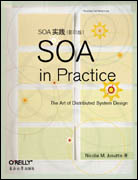
SOA实践(影印版)
出版时间:2008年03月
页数:324
本书将面向服务的架构(SOA)作为一门具体的学科而并非一堆充满希望的云图进行了展示。基于作者在一个大公司实施一套SOA的第一手经验,《SOA实践》解释了SOA怎样才能简化大型应用程序的开发和维护。无论你的项目是涉及一大套基于网络服务的构件,还是要将历史遗存的应用与现代商业流程进行整合,这本书都清楚地阐释了SOA将如何与你的要求相匹配。
SOA作为一个远景已经存在了很多年。本书通过讲解在实践中实现和运行SOA碰到的问题把SOA的远景落到了实处。在定义了SOA的各个方面、检验了典型的使用模式以及探讨了松耦合是如何有助于构建更强的应用程序之后,《SOA实践》呈现了一个框架来帮助你决定何时及如何运用SOA的优势。通过本书你将:
*精确地专注于实际的技术和部署,而不仅仅是各项SOA标准的图示
*在匆忙应用SOA之前,查看商业中的问题来决定哪一个问题适合使用SOA方法来解决
*找到清晰的途径来构建解决方案而不是陷入不断变化的网络服务(Web Service)细节沼泽
*获取一个与SOA紧密相关的系统架构师的经验
“这本书所讲述的原理和实践扮演了很重要的角色,使得T-Mobile的SOA实现成为一个成功案例,每天能够处理一千多万次的服务调用。”
——Dr. Steffen Roehn,执行委员会成员,T-Mobile国际(首席信息官)
“Nicolai Josuttis创造了某些在被过分夸大的SOA世界里罕见的东西:一项基于实践经验且具有深刻见解的思想性工作。本书是一个显著的里程碑,为所有SOA的参与者提出了很多实用的原则。”
——John Schmidt, 主席,Integration Consortium
“本书每位首席信息官、IT主管和IT规划经理应该人手一册。”
——Dr. Richard Mark Soley, 主席和首席执行官,Object Management Group;
执行主管,SOA Consortium
SOA作为一个远景已经存在了很多年。本书通过讲解在实践中实现和运行SOA碰到的问题把SOA的远景落到了实处。在定义了SOA的各个方面、检验了典型的使用模式以及探讨了松耦合是如何有助于构建更强的应用程序之后,《SOA实践》呈现了一个框架来帮助你决定何时及如何运用SOA的优势。通过本书你将:
*精确地专注于实际的技术和部署,而不仅仅是各项SOA标准的图示
*在匆忙应用SOA之前,查看商业中的问题来决定哪一个问题适合使用SOA方法来解决
*找到清晰的途径来构建解决方案而不是陷入不断变化的网络服务(Web Service)细节沼泽
*获取一个与SOA紧密相关的系统架构师的经验
“这本书所讲述的原理和实践扮演了很重要的角色,使得T-Mobile的SOA实现成为一个成功案例,每天能够处理一千多万次的服务调用。”
——Dr. Steffen Roehn,执行委员会成员,T-Mobile国际(首席信息官)
“Nicolai Josuttis创造了某些在被过分夸大的SOA世界里罕见的东西:一项基于实践经验且具有深刻见解的思想性工作。本书是一个显著的里程碑,为所有SOA的参与者提出了很多实用的原则。”
——John Schmidt, 主席,Integration Consortium
“本书每位首席信息官、IT主管和IT规划经理应该人手一册。”
——Dr. Richard Mark Soley, 主席和首席执行官,Object Management Group;
执行主管,SOA Consortium
- PREFACE
- 1 MOTIVATION
- 1.1 Characteristics of Large Distributed Systems
- 1.2 The Tale of the Magic Bus
- 1.3 What We Can Learn from the Tale of the Magic Bus
- 1.4 History of SOA
- 1.5 SOA in Five Slides
- 2 SOA
- 2.1 Definitions of SOA
- 2.2 SOA Drivers
- 2.3 SOA Concepts
- 2.4 SOA Ingredients
- 2.5 SOA Is Not a Silver Bullet
- 2.6 SOA Is Not a Specific Technology
- 2.7 SOA Versus Distributed Objects
- 2.8 SOA Terminology
- 2.9 Summary
- 3 SERVICES
- 3.1 Services
- 3.2 Interfaces and Contracts
- 3.3 Additional Service Attributes
- 3.4 Summary
- 4 LOOSE COUPLING
- 4.1 The Need for Fault Tolerance
- 4.2 Forms of Loose Coupling
- 4.3 Dealing with Loose Coupling
- 4.4 Summary
- 5 THE ENTERPRISE SERVICE BUS
- 5.1 ESB Responsibilities
- 5.2 Heterogeneous ESBs
- 5.3 ESB Differences
- 5.4 Value-Added ESB Services
- 5.5 Summary
- 6 SERVICE CLASSIFICATION
- 6.1 A Fundamental Service Classification
- 6.2 Basic Services
- 6.3 Composed Services
- 6.4 Process Services
- 6.5 Other Service Classifications
- 6.6 Technical and Infrastructure Services
- 6.7 Beyond Services
- 6.8 Summary
- 7 BUSINESS PROCESS MANAGEMENT
- 7.1 BPM Terminology
- 7.2 BPM and SOA
- 7.3 Example for BPM with Services
- 7.4 Business Process Modeling
- 7.5 Other Approaches to Identifying Services
- 7.6 Orchestration Versus Choreography
- 7.7 A Few More Things to Think About
- 7.8 Summary
- 8 SOA AND THE ORGANIZATION
- 8.1 Roles and Organizations
- 8.2 Funding Models
- 8.3 Summary
- 9 SOA IN CONTEXT
- 9.1 SOA-Based Architecture Models
- 9.2 Dealing with Frontends and Backends
- 9.3 Summary
- 10 MESSAGE EXCHANGE PATTERNS
- 10.1 Introduction to MEPs
- 10.2 Basic MEPs
- 10.3 More Complicated MEPs
- 10.4 Dealing with Reliability and Errors
- 10.5 Dealing with Different MEP Layers
- 10.6 Event-Driven Architecture
- 10.7 Summary
- 11 SERVICE LIFECYCLE
- 11.1 Services Under Development
- 11.2 Services in Production
- 11.3 Summary
- 12 VERSIONING
- 12.1 Versioning Requirements
- 12.2 Domain-Driven Versioning
- 12.3 Versioning of Data Types
- 12.4 Configuration-Management-Driven Versioning
- 12.5 Versioning in Practice
- 12.6 Summary
- 13 SOA AND PERFORMANCE
- 13.1 Where Performance Matters
- 13.2 From Remote Stored Procedures to Services
- 13.3 Performance and Reusability
- 13.4 Performance and Backward Compatibility
- 13.5 Summary
- 14 SOA AND SECURITY
- 14.1 Security Requirements
- 14.2 Dealing with Security Requirements
- 14.3 SOA Security in Practice
- 14.4 Security with XML and Web Services
- 14.5 When Security Comes into Play
- 14.6 Summary
- 15 TECHNICAL DETAILS
- 15.1 Services and State
- 15.2 Idempotency
- 15.3 Testing and Debugging
- 15.4 Dealing with Technical Data (Header Data)
- 15.5 Data Types
- 15.6 Error Handling
- 15.7 Summary
- 16 WEB SERVICES
- 16.1 Motivation for Using Web Services
- 16.2 Fundamental Web Services Standards
- 16.3 Web Services in Practice
- 16.4 Closing Notes
- 16.5 Summary
- 17 SERVICE MANAGEMENT
- 17.1 The History of Service Brokers
- 17.2 Repositories and Registries
- 17.3 Summary
- 18 MODEL-DRIVEN SERVICE DEVELOPMENT
- 18.1 Generated Service Code
- 18.2 Modeling Services
- 18.3 Meta Models in Practice
- 18.4 Setting Up MDSD Processes
- 18.5 Tools
- 18.6 Avoiding Bottlenecks
- 18.7 Summary
- 19 ESTABLISHING SOA AND SOA GOVERNANCE
- 19.1 Introducing SOA
- 19.2 SOA Governance
- 19.3 SOA Step-by-Step
- 19.4 Other SOA Approaches
- 19.5 Additional Recommendations
- 19.6 Summary
- 20 EPILOGUE
- 20.1 Is SOA Something New?
- 20.2 Does SOA Increase Complexity?
- 20.3 What Are the Key Success Factors for SOA?
- 20.4 Where Is SOA Not Appropriate?
- 20.5 Does SOA Replace OOP?
- REFERENCES
- GLOSSARY
- INDEX
书名:SOA实践(影印版)
作者:Nicolai M. Josuttis 著
国内出版社:东南大学出版社
出版时间:2008年03月
页数:324
书号:978-7-5641-1143-4
原版书出版商:O'Reilly Media
购买选项